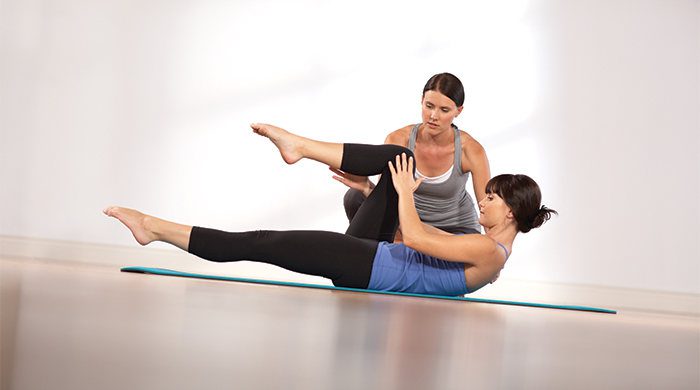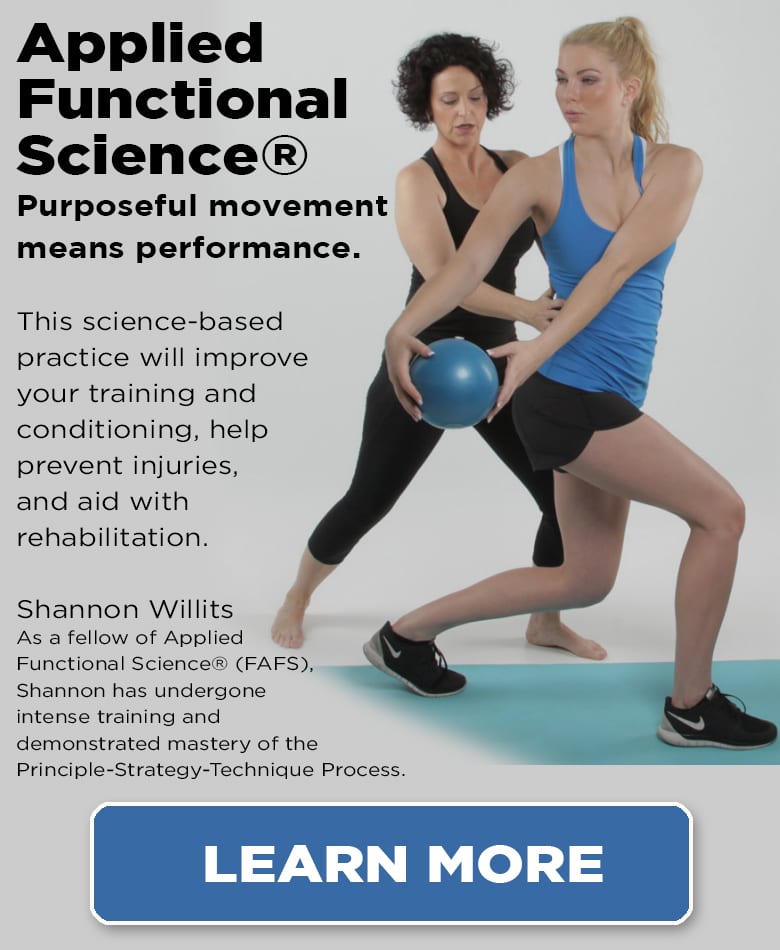 Step 3 – The 5 Basic Principles of STOTT PILATES
Step 3 – The 5 Basic Principles of STOTT PILATES
- Breathing
- Pelvic stability
- Ribcage placement
- Shoulder stability and mobility
- Head placement
I’ve been certified in STOTT Pilates for many years, and I find that the five principles of STOTT PILATES can be applied to any type of movement or workout, making it safe and very effective. I teach many different types of fitness, but I always “Pilatisize” everything!
The key to doing Pilates exercises safely and effectively is through the five basic principles of STOTT Pilates. These five principle elements show you how to breathe properly and position your body through the exercises. They will make you more aware of your core and help you get better results from your workout without injury.
Anatomical Neutral Pelvis and Spine
The preferred position of the body when performing STOTT PILATES exercises is called anatomical neutral. This is how I describe anatomical neutral pelvis and spine:
“When you lie on your back with your knees bent, place the heels of your hands on your hip bones and your index fingers on your pubic bone. These three points should be on the same plane and even with the mat. There should also be a small space underneath your lower back. The back of your ribcage should also be down and the bottom ribs should be in line with your hip bones. Your shoulders and neck should be relaxed.”
Neutral pelvis and spine usually feels very strange to the Pilates novice. I often hear, “I feel like I’m arching my back.” And you may actually be arching your back a bit. It feels odd because traditional fitness (and some old-style Pilates) methods teach you to flatten your back to prepare for an abdominal exercise. Flattening the back engages the rectus abdominus and the glute muscles (the butt), but it doesn’t activate the core muscles – the TVA, multifidus, and pelvic floor –- like contemporary Pilates and anatomical neutral will.
The ultimate goal when doing Pilates is to train your body in neutral pelvis and spine also while prone (face down), seated, kneeling, standing and finally in motion so that you engage the core muscles that are the key to great posture and stability.
Principle One – Breathing
Proper breathing ensures that enough oxygen is flowing to the muscles you are using, and helps prevent unnecessary tension.
In STOTT Pilates, we talk a lot about three-dimensional breathing, a pattern that relaxes you. When you breathe three dimensionally, you expand your rib cage out to the sides and back without allowing your shoulders to lift. You breathe into the lower part of your lungs for the most efficient oxygen exchange. This way of breathing allows for focus and concentration.
This Pilates breathing pattern is the foundation for successfully engaging your abdominal muscles, including the transversus, and stabilizing your torso. It also facilitates correct timing of the transversus abdominus and is the foundation of a healthy functioning core.
Breathing Pattern Exercises
Notice Natural Breath Pattern – Lying on your back, breathe smoothly, noticing your natural breath pattern. Is your breath going into the abdominal cavity, upper chest, sides of rib cage, and back of rib cage?
TVA, Multifidus and Pelvic Floor Breathing – Lying on your back in neutral pelvis and spine, breathe smoothly without neck or shoulder tension. Inhale by drawing the breath in through your nose into the back and sides of the ribcage. Exhale gently through your mouth with pursed lips making the “shhhh” sound. To activate the transversus, multifidus and pelvic floor, on the exhale compress the navel to the spine, and simultaneously lift the pelvic floor. Maintain a stable pelvis and spine in neutral. Do not tilt the pelvis!
Activation Imagery
Think of the transversus abdominus like a corset, the multifidus like the laces of the corset on your back and the pelvic floor like a hammock. When your inhale through your nose, expand the ribcage as if the corset is widening, the laces are expanding and the hammock is dropping (remain relaxed and do not force anything). When you exhale, imagine that the corset is tightening around your trunk, the laces are tightening and the hammock is lifting. Remain in neutral position throughout the breathing exercises. Repeat this for five to 10 breaths.
Principle Two – Pelvic Stability
STOTT PILATES emphasizes stabilization of the pelvis and lumbar spine (lower back) in either a neutral or an imprinted position.
Neutral: As mentioned earlier, neutral pelvis and spine maintains the natural curve of the lower back. Again, when lying on your back in neutral, the front of your hip bones and pubic bone should lie even with the mat, and your lower back should not be pressed into the mat. This is the most stable and optimal shock-absorbing position for your spine. Make sure you’re not over-arching your back or popping your ribcage to achieve neutral alignment. While breathing and engaging abdominals in this position, you should not feel strain through your lower back. If you feel muscle tension, shift the pelvis to a more comfortable position.
Imprint: An alternate to neutral is known as “Imprint” and is a good option when neutral is too challenging or uncomfortable. In Imprint, your lower back is closer to the mat. Imagine a small bird egg under your back. Avoid pressing your lower back all the way into the mat or tilting your pelvis too far by overusing your rectus abdominus or glutes, and breaking the egg. You’ll know you’re overusing the rectus abdominus because you’ll see a bulge.
Pelvic Stability Exercises
Starting position – Lying on your back, with your pelvis and spine in neutral. Knees are bent, feet are hip-distance apart on the mat. Arms are long by sides, palms down.
Rocking Pelvis – Rock pelvis, alternating arching lower back off floor and pressing lower back into floor. Neutral placement will be somewhere between the two.
Neutral to Imprint – Inhale prepare, exhale contract abdominals to move pelvis and spine into imprint, flattening your abs (don’t push out or pop your abs). Bring your hip bones and rib bones closer together while maintaining a small space under your back without any neck or shoulder tension. Inhale and maintain imprint. Exhale and return to neutral. Repeat five to 10 times.
Leg Lifts – To prepare inhale, exhale to imprint pelvis and spine, inhale stay and exhale lift one foot off of the mat with knee bent 90 degrees and over hip while maintaining imprint. Inhale stay, exhale and return foot to mat. Repeat other side. Continue sequence for five to 10 sets with the goal of maintaining imprint throughout the sequence.
Principle Three – Ribcage Placement
The rib cage position affects the alignment of the thoracic (upper) spine. When lying on your back in a neutral position, maintain the sense of the weight of your ribs resting gently on the mat (i.e. maintain the normal curve of the upper back). Don’t lift off or push your rib cage into the mat. Pay particular attention to the placement of your rib cage when inhaling or while performing arm movements overhead.
Using the breath pattern described below and engaging your abs will help stabilize your rib cage. Emphasize breathing into your back and sides of your rib cage during inhalation. When you exhale, allow your ribs to soften, with the two sides gently closing in toward each other.
Ribcage Placement Exercises
Breath pattern – Inhale through your nose, feeling the sides and back of the ribcage expand – like an accordion. Exhale though pursed lips, like you’re blowing out a candle, allowing the ribcage to close.
Arm Raises – Inhale through your nose, lifting your arms straight up from the shoulders with fingertips to the ceiling, exhale reach your arms overhead while maintaining stability through the front of the ribcage. Only reach overhead as far as you can maintain the ribcage stability. This will be important when executing shoulder and arm exercises. Repeat sequence five to 10 times.
Principle Four – Shoulder Stability and Mobility
Stabilizing your scapulae (shoulder blades) on the back of the rib cage is as important as contracting your abs during the initiation of every exercise. This will help you avoid strain through your neck and upper shoulders.
A sense of width should be maintained across the front and back of your shoulders to achieve proper placement. In other words, make sure you neither allow your shoulders to round forward too much nor squeeze together toward the spine too much. Shoulders should not be lifted too far, or over-depressed. Placement should be somewhere between these two positions. The shoulder blades have a large range of motion, so remember to maintain stability (but not rigidity) at all times: a) when the spine is neutral and the arms are resting; b) when the spine is moving, and; c) when the arms are moving in any direction.
Shoulder Stability and Mobility Exercises
Scapula Isolations (Protraction & Retraction) – Lying on your back in neutral and fingertips reaching up toward the ceiling. Inhale prepare, exhale draw the borders of the shoulder blades gently together and toward the spine without pinching, inhale draw the borders of the shoulder blades away from each other and away from the spine while reaching up and keeping the arms straight. Repeat five to 10 times.
Scapula Isolations (Elevation & Depression) – Lying on your back in neutral with arms long and down by your sides. Inhale to lift the shoulders up without rotating forward and exhale to reach the fingertips down while lowering the shoulder blades. Repeat five to 10 times.
Arm Circles – Lying on your back in neutral position with arms long and down by your sides. Inhale to prepare, exhale reaching straight arms straight over your head and circling the arms around the sides, returning to the starting position and keeping the pelvis, spine and ribcage stable. Repeat five to 10 times and reverse.
Principle Five – Head Placement
When sitting, lying and standing, your cervical spine [neck] should hold its natural curve with your head balanced directly above your shoulders. In some cases, a small pillow should be used when lying on your back to put your head and neck in a comfortable position. Whenever you lift your head and upper body from the mat, lengthen the back of your neck and nod your head down without jamming the chin into the chest. There should be enough room to fit your fist between your chin and chest. Once your head is in the proper position and your shoulder blades are stabilized (Principle 4), the upper torso can be lifted by contracting the abs and sliding your rib cage toward your pelvis.
When lying on your stomach and lifting your upper torso, pay particular attention to maintaining an even line from your upper back to your neck. Avoid lifting your head too high and crunching up the back of your neck.
Head Placement Exercise
Practice doing head nods properly before lifting your head and shoulders off the mat. Avoid jamming your chin into your chest, which results in too much compression of the neck.
Head Nods – Lying on your back in neutral position with knees bent and arms long and down by your sides. While keeping the back of your head on the mat, inhale and nod your head taking your eye level to just over your knees. Exhale and return to start. Repeat five to 10 times.
AB Prep – Lying on your back in neutral position with knees bent and arms long and down by your sides. Inhale to nod the head, exhale to lift your head, neck and shoulders off of the mat without flattening out your lower back. Inhale to stay and exhale to roll down to neutral position.Breast Stroke Prep – Lying face down with your legs hip width apart, your navel to your spine and your forehead on the mat. Inhale to prepare by sliding your shoulder blades down and slightly together, exhale to gently press into the hands while lifting the head, neck and shoulders off of the mat to the bottom of the ribcage. Inhale to stay and exhale to return to the mat.
These 5 Basic Principles of STOTT PILATES are the foundation of a safe and effective Pilates workout. If you apply them to each and every exercise that you perform, you will get great results and be successful in achieving a flat abdomen and a strong and stable core.
Step 4 will publish on Dec 28, 2022



